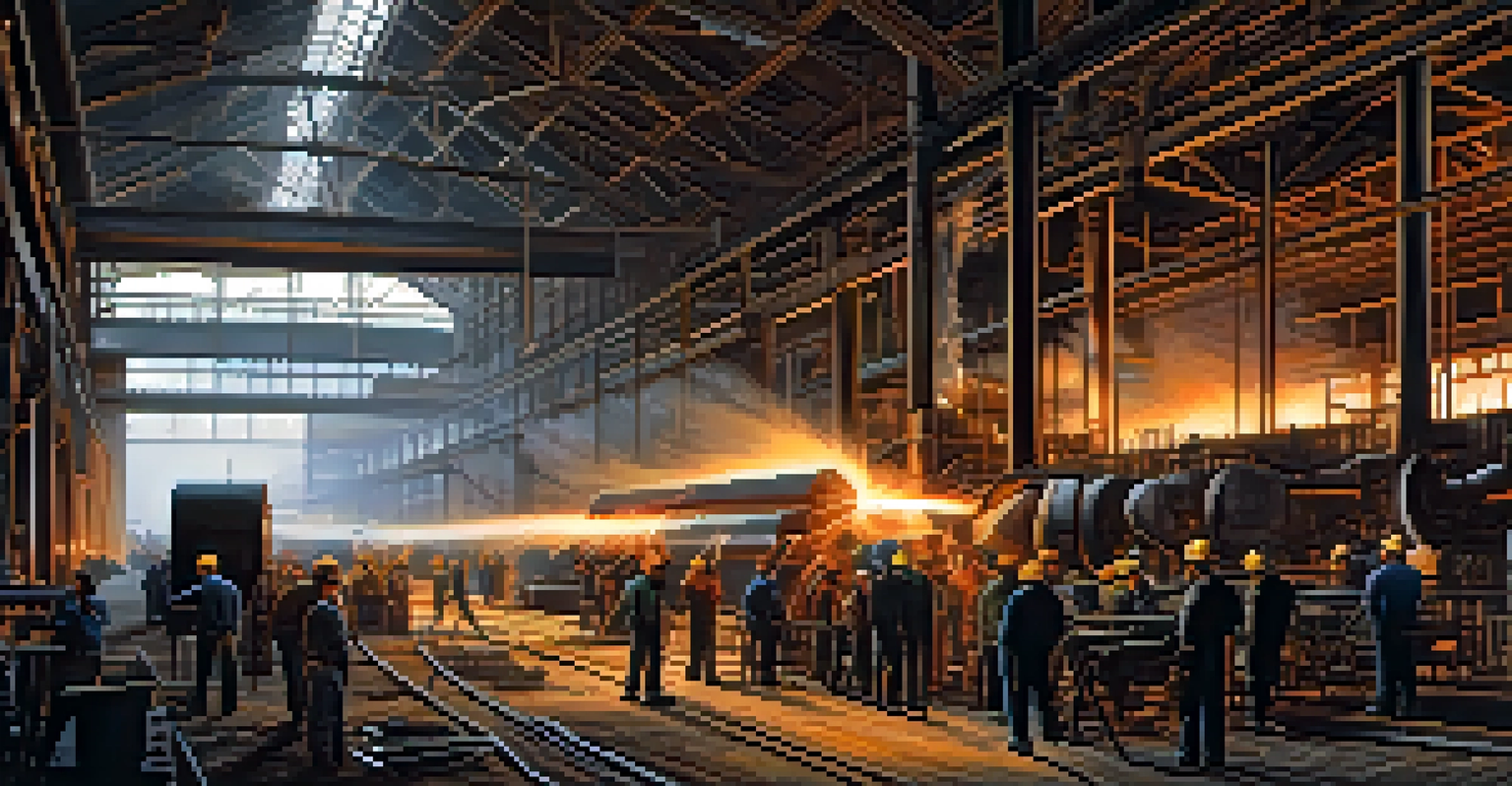Buffalo's Economic Growth: From Trade to Industry

The Early Days: Buffalo as a Trade Hub
Buffalo's economic story began as a vital trade hub in the 19th century. Located at the eastern end of Lake Erie, it provided an essential link between the Great Lakes and the Atlantic Ocean via the Erie Canal. This strategic position allowed Buffalo to flourish, attracting merchants and traders eager to capitalize on the bustling commerce.
Buffalo is a city that has always reinvented itself, adapting to the times and challenges it faces.
As goods flowed through the city, it became a melting pot of cultures and ideas, with immigrants arriving in droves to seek their fortunes. The increase in population and diversity not only enriched the city's fabric but also fueled its economy. Buffalo quickly developed a reputation for being a center of industry and trade, setting the stage for its future growth.
By the late 1800s, Buffalo had established itself as one of the most important ports in the United States, handling millions of tons of cargo. This foundation of trade laid the groundwork for the city's transformation into an industrial powerhouse, as entrepreneurs began to see the potential of manufacturing alongside commerce.
The Industrial Revolution: A Shift in Focus
The Industrial Revolution brought significant changes to Buffalo, as factories began to sprout up across the landscape. This shift from trade to industry was marked by the rise of manufacturing sectors such as steel, grain, and railroad components. Buffalo quickly became synonymous with production, offering jobs to thousands and driving economic growth.

As industries flourished, so did the city's infrastructure. New railroads and shipping routes were established to support the booming manufacturing scene. These improvements not only facilitated the movement of goods but also attracted even more businesses to Buffalo, creating a robust economic ecosystem.
Buffalo's Trade Hub Origins
Buffalo's strategic location at Lake Erie and the Erie Canal made it a vital trade hub in the 19th century, attracting diverse cultures and fueling economic growth.
During this period, Buffalo's population swelled, largely due to the influx of workers seeking employment in its factories. The city's identity evolved, transitioning from a trade-centric community to a vibrant industrial center, shaping the lives of its residents and the region's economy.
Key Industries That Shaped Buffalo's Economy
Buffalo's economic landscape was greatly influenced by several key industries, particularly steel and automobile manufacturing. Companies like Bethlehem Steel and Ford established significant operations here, providing employment and driving innovation. The steel industry, in particular, became a cornerstone of Buffalo's economy, attracting skilled labor and supporting related businesses.
The measure of a city's success is not just in its economic output but in its ability to foster a community that thrives together.
Additionally, the grain industry played a vital role, with Buffalo's grain elevators becoming some of the largest in the world. This not only reinforced the city's status as a shipping hub but also positioned it as a leader in agriculture and food processing. The combination of these industries helped Buffalo withstand economic fluctuations over the years.
In the mid-20th century, Buffalo was often referred to as the 'City of Light' because of its thriving industries and technological advancements. The synergy between these key sectors created a dynamic economy, showcasing Buffalo's resilience and adaptability amidst changing market conditions.
The Challenges of Deindustrialization
As the latter half of the 20th century approached, Buffalo faced significant challenges due to deindustrialization. Many factories began to close or relocate, leading to job losses and economic decline. This shift was exacerbated by globalization and technological changes that made manufacturing less viable in the region.
The impact of these closures was profound, with neighborhoods suffering from disinvestment and population decline. Buffalo, once a booming industrial city, found itself grappling with the consequences of an economy that was rapidly changing. Many residents faced uncertainty as they sought new employment opportunities in a transforming job market.
Shift to Industrial Powerhouse
The Industrial Revolution transformed Buffalo into an industrial powerhouse, establishing key manufacturing sectors like steel and grain, which drove job creation and economic expansion.
However, this period of struggle also sparked a wave of community resilience and innovation. Local leaders and organizations began to focus on revitalization efforts, seeking to reimagine Buffalo's economic future beyond its industrial roots.
Revitalization Efforts: The Path to Recovery
In response to the challenges posed by deindustrialization, Buffalo launched a series of revitalization efforts aimed at economic recovery. These efforts included attracting new businesses, investing in infrastructure, and promoting tourism. City leaders recognized the need for a diversified economy that could withstand future challenges.
One successful initiative involved the development of the Buffalo Niagara Medical Campus, which attracted healthcare and research organizations. This shift towards knowledge-based industries not only created jobs but also positioned Buffalo as a hub for innovation and education.
Additionally, the city focused on enhancing its cultural and recreational offerings, showcasing its history and natural beauty. By prioritizing quality of life and economic development, Buffalo began to emerge as a vibrant community with a promising future.
The Role of Education and Workforce Development
Education and workforce development have become crucial components of Buffalo's economic growth strategy. Local colleges and universities, such as the University at Buffalo, play a significant role in preparing the workforce for the demands of modern industries. By aligning educational programs with industry needs, these institutions help ensure that residents are equipped with relevant skills.
In addition to traditional education, various training programs and partnerships have emerged to support workforce development. These initiatives aim to provide individuals with the necessary skills to succeed in growing fields, such as technology and healthcare. As a result, Buffalo is fostering a culture of lifelong learning and adaptability.
Revitalization and New Opportunities
In response to deindustrialization, Buffalo focused on revitalization efforts, diversifying its economy through initiatives in healthcare, education, and technology, fostering a culture of innovation.
This commitment to education not only benefits individuals but also strengthens the local economy. A well-educated workforce attracts businesses looking for talent, creating a positive cycle of growth and opportunity for Buffalo's residents.
Buffalo Today: A Diverse and Thriving Economy
Today, Buffalo boasts a diverse economy that reflects its rich history while embracing the future. While manufacturing still plays a role, the city's economy has expanded to include sectors like healthcare, education, and technology. This diversification helps create stability and resilience, allowing Buffalo to thrive in a rapidly changing world.
Moreover, Buffalo has become a hub for innovation, with numerous startups and entrepreneurial ventures emerging across various industries. This dynamic environment fosters creativity and collaboration, attracting new residents and businesses eager to be part of the city's transformation.

As Buffalo continues to evolve, it honors its past while looking forward to new opportunities. The city's commitment to growth, innovation, and community engagement ensures that it remains a vibrant place to live and work, showcasing the power of resilience in the face of change.